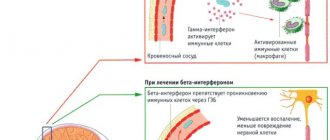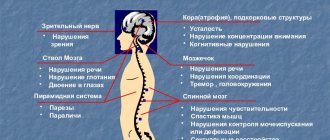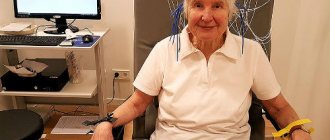Modern world neurology has made significant progress in the treatment of multiple sclerosis. If 10 - 15 years ago the prognosis of this chronic disease was often disappointing, and it ended in disability and death, today this scenario can increasingly be avoided.
Our expert in this field:
Lashch Natalia Yurievna
Neurologist of the highest category, candidate of medical sciences, associate professor. Laureate of the Moscow City Prize in the field of medicine.
Call the doctor Reviews about the doctor
This does not mean curing multiple sclerosis completely. But this means preserving a person’s ability to live a full life and avoid loss of ability to work. This means achieving stable, long-term remission, preventing exacerbations or making them rare, minimizing symptoms and residual effects.
Multiple sclerosis has three main forms: relapsing-remitting, secondary progressive and primary progressive.
The relapsing form means the appearance of primary symptoms, which pass relatively quickly, after which remission occurs. In this case, complete recovery occurs, there are no residual effects. This favorable state can last for several years. After this, a relapse occurs, and from now on exacerbations become regular. They occur more frequently and their form becomes more severe. This means that the disease has taken a secondarily progressive form.
After each exacerbation, residual effects persist - muscle weakness, numbness, paralysis, decreased mental performance, deterioration of cognitive abilities and memory.
A person gradually loses the ability to move independently. At first he is forced to rely on a cane when walking, then moves into a wheelchair. This development of the disease is the most typical.
The primary progressive form means the absence of exacerbations and remissions. The disease develops continuously, neurological symptoms increase more and more. Each of the newly appeared symptoms no longer disappears, but remains forever and only gets worse over time.
The latest methods of treating multiple sclerosis that we use give good results in all three forms of the disease. In the relapsing form, they help to prolong remission as much as possible, prevent the onset of a secondary progressive stage, or make it less dangerous. This means avoiding disability.
In the case of a primary progressive form of the disease, our techniques help to slow down the development of the disease and also avoid disability.
Our methods
What are these new techniques that we offer today in our medical center?
First, these are the newest disease- modifying drugs for multiple sclerosis (DMDs). Over the past decades, drugs have appeared that are significantly more effective than anything that was used before. Every year, clinical trials are carried out and new DMTs are introduced into practice. We closely monitor this process and use all the best developments that have proven their advantages.
Secondly, this is a method of preliminary blood purification, which significantly improves the results of drug therapy.
Thirdly, it is a diagnostic method that shows the onset of relapse before symptoms appear. This allows us to take preventive measures and avoid exacerbation or alleviate it as much as possible in order to avoid complications, residual effects and their accumulation, and ultimately disability, and to maintain full physical and mental activity for our patient.
Risk of complications and rejection
When a patient’s own stem cells are introduced into the patient’s body—autologous transplantation—the risk that rejection will occur is extremely low. After all, the immune system will perceive them as “family.”
An exception may be people with autoimmune pathologies - for example, systemic lupus erythematosus. In this case, additional immunosuppressive medications will be required.
Complications during transplantation are possible:
- if the amount of biomaterial is incorrectly selected;
- proper sterility was not observed during the procedure;
- the body was not previously prepared - a high concentration of already damaged immune cells in the bloodstream;
- the interval between the stages of introducing stem cells is not maintained.
However, the highest risk occurs if the patient receives stem cells from another person . Even death is possible. Therefore, many medical centers do not practice such stem cell transplantation at any stage of multiple sclerosis.
Pulse therapy
To relieve acute symptoms of multiple sclerosis, the international clinic Medica24 uses pulse therapy - slow intravenous administration of the hormonal drug - 6-methylprednisolone.
This glucocorticoid drug has a powerful and rapid anti-inflammatory, membrane-stabilizing, anti-edematous effect and helps to significantly improve the patient’s condition within 3 to 7 days.
Before prescribing a course of pulse therapy, our clinic conducts an examination to exclude contraindications.
In particular, gastroduodenoscopy is performed to exclude gastric and duodenal ulcers. Other contraindications must be excluded - infectious diseases, decompensated diabetes mellitus, tuberculosis.
The main advantage of pulse therapy is its exceptional effectiveness. Its results significantly exceed the possibilities of oral use of hormonal or other drugs.
Already in 3 - 7 days, a significant improvement in the condition is achieved - numbness and weakness in the arms and legs disappear, vision improves, dizziness, coordination problems, unsteadiness when walking and other symptoms associated with damage to the spinal cord, cerebellum, and brain stem disappear.
Acute symptoms disappear, the development of the disease slows down, and the condition improves (symptom regression).
The drug 6-methylprednisolone is administered intravenously through a dropper. Treatment protocols correspond to the most effective regimens, the results of which have been objectively confirmed by clinical studies and are today considered the “gold standard” of pulse therapy for multiple sclerosis. In this case, the individual characteristics of the patient are taken into account.
Pulse therapy at the international clinic Medica24 is prescribed based on MRI data with contrast (to identify active foci of demyelination), as well as an assessment of the patient’s condition when new symptoms appear or exacerbation of previous symptoms.
The doctors at our clinic have extensive experience in conducting this type of treatment and timely correction of side effects.
The treatment course is recommended to be carried out in a hospital setting. This guarantees maximum safety and best effectiveness of pulse therapy.
Intravenous administration of a hormonal drug has a powerful therapeutic effect, but along with this there are side effects.
Some of them are relatively minor - dizziness, euphoria, hiccups, nausea, insomnia, anxiety.
Others may be more serious - blood pressure surges, bleeding, hyperglycemia, cardiac arrhythmia.
In order to promptly stop these side effects and adjust the treatment course, it is better for the patient to stay in a hospital, under medical supervision.
Request a call back. We work around the clock
Message sent!
expect a call, we will contact you shortly
Stages of transplantation
The procedure for restoring the myelin sheath of a nerve fiber by transplantation is the main goal of therapy for multiple sclerosis, and is carried out in three stages. As a rule, specialists first assess the initial state of a person’s health and determine the stage at which the disease is located.
Then you need to obtain biomaterial for transplantation - stem cells. To do this, blood is taken from a person - through a standard intravenous system it enters a specially designed device. It is he who helps differentiate the necessary ones from hundreds of thousands of blood cells.
There may be a small number of them in the peripheral bed. Sometimes, to obtain the required volume, 3–4 procedures are performed. The cells are then frozen and stored until transplantation.
At the second stage of transplantation, it is necessary to destroy immune cells already damaged by the pathological process. In order to solve this problem, the following is introduced into the human body:
- immunosuppressive medications - suppress unhealthy immune system activity that damages the myelin fiber of nerve endings;
- anti-inflammatory drugs - reduce the severity and extent of inflammatory foci in both the brain and spinal cord.
The complex effect allows you to prepare the human body for further stem cell transplantation. They are defrosted in a special mode and then enter the bloodstream through the intravenous system. All stages of transplantation are carried out in specialized hospital clinics.
Diagnostic features
Multiple sclerosis is a disease in which active immune system cells attack and destroy the myelin sheath of nerves. Hereditary factors, intoxication, lifestyle, nervous stress, and acute viral or bacterial infections may play a role in the development of this autoimmune disease. For one reason or another, the immune system begins to behave aggressively towards the body's own cells.
Multiple sclerosis affects the white matter of the brain. Unlike gray matter, which is formed by neurons, it consists of axons. These processes serve as conductors of nerve signals. The shortest of them are only a few millimeters long, the longest - up to one and a half meters or more. Like wires that carry electrical current, axons have an external insulation.
Bundles of nerve fibers, motor and sensory, have the same external insulation. The former are responsible for muscle contractions, the latter for the perception of visual, auditory, olfactory, gustatory, and tactile sensations. The insulating sheath of axons and nerves consists of myelin, a complex protein-lipid substance.
When an autoimmune process develops, aggressive cells of the immune system attack the myelin and destroy it. Areas of exposed axons and nerves arise, in place of which plaques form. Because of this, the speed of transmission of nerve signals decreases sharply (5-10 times). At the same time, the inflammatory process and intoxication develop, which leads to the death of nerve tissue. Because of this, irreversible changes develop, which ultimately lead to disability and death.
The process of formation of compactions and plaques is called sclerosis. These plaques form in large numbers and are scattered throughout the central nervous system - in the brain and spinal cord. Hence the name of the disease - multiple sclerosis.
Slowing of nerve signals and destruction of nerve tissue results in symptoms that usually begin in the legs. An organism affected by a disease can be figuratively compared to a tree whose foliage begins to die and its branches begin to die. While the lower ones have already died, the upper ones look quite healthy. But it's a matter of time. Once the disease has begun to develop, it will spread higher and higher.
First, a person feels weakness and numbness in the feet, then in the legs, and in the hips. Possible sensations of tingling, burning, and crawling. All these are signs of innervation disturbances, which can easily be mistaken for a manifestation of a spinal disease, for example, a protrusion or hernia.
The matter is complicated by the fact that in recent decades degenerative-dystrophic diseases of the spine have become widespread. The doctor prescribes an MRI, which actually shows the presence of a problem, for example, in the lumbar region. This is a very obvious and simple explanation of the symptoms, on the basis of which the doctor prescribes treatment. This may be surgery to remove the disc, which has no effect. Symptoms persist because they are caused by multiple sclerosis. It is good if the disease is diagnosed at least after the first unsuccessful operation.
Weakness in the legs is increasing, but now the genitourinary and excretory systems are involved in the process. The normal processes of defecation and urination are disrupted and occur uncontrollably. Weakness and numbness spread to the hands, it becomes difficult to hold objects, make normal movements, and take care of oneself in everyday life. Moving upward, the disease can lead to paralysis of the respiratory system and heart. The person ends up in the intensive care unit, under a ventilator.
There are times when doctors, having failed to detect multiple sclerosis, instead recommend treating, for example, chronic fatigue syndrome. After all, the central nervous system is not only muscle contractions, but also mental activity. Depending on which nerves are attacked by the immune system, certain initial symptoms of the disease occur. This may be a feeling of constant fatigue, decreased memory, attention, concentration, mental performance, increased fatigue, weakness. Forgetfulness and absent-mindedness appear, which are accompanied by depression or increasing apathy. Sleep becomes intermittent, restless, accompanied by frequent awakenings, nightmares, and insomnia develops. All this can be taken as signs of astheno-neurotic syndrome, or chronic fatigue syndrome. Psychotropic drugs and nootropic drugs are prescribed, which give practically no results. The disease continues to progress.
Early symptoms may also include blurred vision, hearing, poor coordination of movements, and unsteady gait. Such a multiple picture often leads to the fact that a person goes from doctor to doctor, and each one prescribes him a new treatment, conservative or surgical.
Meanwhile, it is enough to do a relatively simple examination to establish the true cause of the symptoms - multiple sclerosis. The basis for diagnosis is MRI data of the brain. Magnetic resonance imaging not only shows foci of demyelination (plaques), but also allows you to distinguish new, young from old. Using a contrast agent, the doctor can see fresh destruction of the myelin sheath of the nerves, as well as areas of inflammation and necrosis of the nerve tissue.
Electroneuromyography is used to assess the speed of transmission of nerve signals. The examination and diagnosis takes only one day.
Another important diagnostic indicator is a blood test for antibodies to myelin. Multiple sclerosis is an autoimmune disease. Based on the content of specific antibodies aggressive to myelin antigens, one can obtain reliable information about the stage of development of the disease and the degree of its danger. The same indicator helps to predict the imminent onset of exacerbation of a secondary progressive form of the disease.
A general immunogram allows you to assess the state of the immune system as a whole and the degree of its changes against the background of multiple sclerosis.
We will call you back
Message sent!
expect a call, we will contact you shortly
Symptoms and signs
To begin treating a disease, you first need to recognize it. Since the pathology is based on damage to the nerve fibers along which impulses travel from the brain to the internal organs, the clinical picture will depend on in which part of the body the pathological focus has formed.
Manifestations of multiple sclerosis:
- trembling of the limbs - at first barely noticeable and periodic, it intensifies as the disease progresses, becoming widespread and prolonged;
- disturbance of the perception of the body in space - when moving, the feet seem to lose the feeling of solid ground, “walking on wobbly legs”;
- coordination of movements loses its clarity - from the outside a person may seem drunk;
- loss of control over the facial nerves - part of the face shifts to one side;
- tingling in certain areas of the skin - a feeling of numbness;
- pathological strengthening or weakening of muscle tone;
- failure in the process of urination - most often due to incontinence.
Neurological symptoms will be expressed in changes in the patient’s mood, tearfulness or euphoria, attacks of depression and decreased self-esteem.
Before deciding whether a stem cell transplant is permissible, the doctor must conduct a thorough neurological examination and instrumental studies of the nervous system.
Features of treatment
The standard treatment is drugs that correct the functioning of the immune system, reduce its aggressiveness, and suppress pro-inflammatory factors. They are called DMTs—course-modifying drugs for multiple sclerosis. The effectiveness of such treatment may be high or low. They help some, not or hardly help others. In this case, the doctor changes the medications and adjusts the therapy.
The effectiveness of drug treatment depends on two factors. The first is the drugs themselves. Often in our country the same drugs that were prescribed fifty years ago are used. While in world neurological practice much more effective DMTs are used. This is due to the fact that the achievements of world pharmacology are not always properly monitored, and drugs are introduced into practice with a delay. For many patients, this means a poor prognosis for the disease.
We try to avoid this mistake and promptly use all the best, latest, innovative world developments, and use European treatment protocols. The medication course is prescribed and adjusted individually. Neurologists, immunologists, and doctors of other specialties participate in the joint management of the patient. An interdisciplinary approach helps to select the optimal medications and, as a result, achieve stable, long-term remission, eliminate symptoms and allow the person to continue a normal, healthy life.
The second factor is the fundamental feature that distinguishes the treatment of multiple sclerosis in our clinic. Few or almost no one pays attention to it, but in vain.
The fact is that when prescribing certain drugs, doctors almost never attach importance to the most important circumstance - into which blood the active substance enters.
But the blood in multiple sclerosis is extremely polluted. It is saturated with breakdown products of the myelin sheath. It contains a high concentration of antibodies that destroy and have already destroyed myelin. This is a very unfavorable environment, which obviously reduces the effectiveness of the drug or completely reduces it to zero.
But it is enough to remove all these impurities, cleanse the blood, and the effectiveness of the drug increases significantly, sometimes many times over. This makes it possible to obtain completely different treatment results.
You can compare this with a simple example. If the drug is used to treat a runny nose when the nasal passages are blocked and mucus accumulates in them, its effectiveness may be low. But once you clean, thoroughly rinse the nasal passages, and after that apply the treatment, its results will be completely different.
Therefore, before starting a course of drug therapy for DMT, we purify the patient’s blood using plasmapheresis. This procedure consists of separating the blood into red blood cells and plasma, which contains contaminants such as antibodies and myelin breakdown products. After this, the dirty blood plasma is removed and replaced with clean plasma.
After this, the active drug (DITRS) enters the purified blood. The practice of our clinic shows that this sequence of actions allows us to achieve stable remission and restore health even in cases where simple drug therapy has produced virtually no results.
In severe cases, inpatient treatment is required, but outpatient treatment and procedures performed in the day hospital of our clinic are often sufficient to achieve positive results.
Who can be a donor for the treatment of multiple sclerosis?
The essence of the Bulgarian approach to treating multiple sclerosis is very similar to bone marrow transplantation for leukemia. A small amount of bone marrow is taken from a healthy person and transplanted into the patient. The most important and difficult thing in this process is choosing a donor. In this case, the main thing is the compatibility of the donor and recipient not so much in terms of blood group (AB0 system), but rather in terms of tissues. Most often, the ideal donor for multiple sclerosis is a sibling. Less often - parents. If tissue compatibility with close relatives is absent or low, then a donor is selected in the NMDP registry.
NMDP is an American database that contains relevant information on 6.5 million donors. There is also a German database where there is information about 5 million donors. And yet, if the patient is of a rare nationality, it is difficult to select a donor. This is due to the genetic difference between nations. Any person no younger than 18 and no older than 55 can be a donor. It is very important that donors never suffer from diseases such as hepatitis B, malaria, tuberculosis, cancer and mental disorders. This is what is checked for everyone who wants to become a donor. If the patient saved his own stem cells in a cryobank before the onset of multiple sclerosis, then these cells can also be used.
Condition monitoring
Another feature of our approach to treating multiple sclerosis is control of the condition. Regular tests make it possible to anticipate and prevent exacerbation of the disease in time, to catch it at a stage when it has not yet had time to lead to irreversible consequences.
This means that a person continues to live a healthy, normal, fulfilling life, monitoring his condition from time to time. To do this, it is enough to do a blood test once every three months for the presence of antibodies to myelin.
It would seem that everything is simple. But it is surprising that such an effective method is practiced relatively rarely; treatment usually begins after the symptoms of an exacerbation appear. But it can be avoided. It never arises suddenly and instantly. It is preceded by an increase in specific antibodies in the blood. Regular monitoring of these indicators is enough to completely control a person’s condition.
In practice, this means that a person has completed a course of drug therapy, as a result of which remission was achieved. The symptoms have disappeared and the person continues to live a normal life. From time to time he comes to our center and does a blood test for antibodies.
They can remain at low levels for a long time. This means that there is no threat to health. But suddenly another analysis shows a significant increase in the level of antibodies. This means that if measures are not taken, an exacerbation will soon occur.
Forewarned is forearmed. We take preventive measures and aggravation is avoided. This may be plasmapheresis or its combination with drug therapy, it all depends on the individual case.
Sign up for an appointment with the doctor
Message sent!
expect a call, we will contact you shortly
Successful treatment of multiple sclerosis
This technique may be considered relatively new, but to date, 500 people have already received treatment for multiple sclerosis using stem cell transplants. Up to 70% of patients have been cured of multiple sclerosis in this way, and are gradually returning to normal life. As we can see, statistics speak in favor of developing this method of treatment and introducing it into widespread practice. Of course, people under the age of 35 respond best to transplantation. After all, the older a person is, the greater the risks. But those who take the risk can achieve a complete recovery from multiple sclerosis.
Specialists from countries such as Bulgaria, Great Britain, the USA, Israel and Germany successfully practice bone marrow transplantation for the treatment of multiple sclerosis. Proving that it can be completely cured in 3-4 months.
Contact us, they speak Russian here:
Contact person: Karina Weiner
Tel: +97
Website: https://nl-assistance.org/ Social networks: https://www.facebook.com/nlassistance/ https://t.me/newlifeassistance https://www.instagram.com/newlifeassistance/
Apply for treatment
By pressing this button, you receive a quick response and an individual decision from the doctor
Treatment protocol
Mesenchymal stem cells - your own or a donor - are injected intravenously or intrathecally (into the spinal canal). Professor Slavin’s method involves drawing up an individual therapeutic regimen for each patient. Patients with multiple sclerosis are advised to contact the clinic in advance and provide the doctor with the necessary medical documents. As a rule, a single course of treatment is required, for which you need to come to the clinic in Tel Aviv for 1 week.









